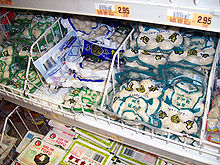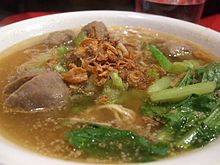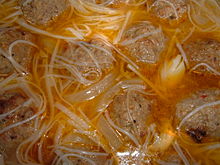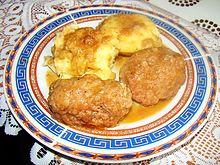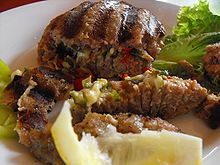- Meatball
-
 Meatballs served Swedish style. with mashed potatoes, brown-sauce, lingonberry-jam and pickled gherkins
Meatballs served Swedish style. with mashed potatoes, brown-sauce, lingonberry-jam and pickled gherkins
A meatball is made from an amount of ground meat rolled into a small ball, sometimes along with other ingredients, such as breadcrumbs, minced onion, spices, and possibly eggs. Meatballs are usually prepared and rolled by hand, and are cooked by frying, baking, steaming, or braising in sauce.
There are many kinds of meatball recipes using different types of meats and spices, including vegetarian and fish alternatives, and various methods of preparation.
The ancient Roman cookbook Apicius included many meatball-type recipes.[citation needed] From the Balkans to India, there is a large variety of meatballs in the kofta family.[citation needed]
Contents
Meatballs across various cultures
- In Afghanistan, meatballs are used as a traditional dish with homemade soups, or are made with a tomato based sauce that may include some plum seeds to increase tartness and is served with bread or rice which is called Kofta-Chelou. Now meatballs are also grilled on top of pizza.
- Albanian fried meatballs (qofte të fërguara) include feta cheese.
- In Austria, fried meatballs are called Fleischlaibchen or Fleischlaberl.
- In Belgium, meatballs are called ballekes or bouletten in Flanders, and are usually made of a mixture of beef and pork with breadcrumbs and sliced onions. Many other variations exist, including different kinds of meat and chopped vegetables.
- Chinese meatballs (specifically, a dish common in Shanghai cuisine) are most often made of pork and are usually steamed or boiled, either as-is, or with the addition of soy sauce. Large meatballs, called lion's heads, can range in size from about 5 cm to 10 cm in diameter. Smaller varieties, called pork balls, are used in soups. A Cantonese variant, the steamed meatball, is made of beef and served as a dim sum dish. A similar dish is called the beef ball, and the fish ball is yet another variety made from pulverized fish. In northern China, irregular balls made from minced meat and flour are often deep-fried and eaten for special occasions.
- Danish meatballs are known as frikadeller and are typically fried, and they are usually made out of ground pork, veal, onions, eggs, salt and pepper; these are formed into balls and flattened somewhat, so they are pan ready.
- In Finnish cuisine, meatballs (lihapullat) are made with ground beef or a mix of ground beef and pork, or even with ground reindeer meat, mixed with breadcrumbs soaked in milk and finely chopped onions. They are seasoned with white pepper and salt. Meatballs are traditionally served with gravy, boiled potatoes (or mashed potatoes), lingonberry jam, and sometimes pickled cucumber.
- In Germany, meatballs are mostly known as Frikadelle, Fleischpflanzerl, Bulette or Klopse. A very famous variant of meatballs are Königsberger Klopse, which contain anchovy or salted herring, and are eaten with caper sauce.
- In Greece, fried meatballs are called keftédes (κεφτέδες) and usually include within the mix bread, onions and mint leaf. Stewed meatballs are called yuvarlákia (γιουβαρλάκια: from the Turkish word yuvarlak, which means "round") and usually include small quantities of rice.
- In Hungary, as well as territories from neighbouring countries where Hungarian is spoken, a meatball is called fasirt or fasirozott ([ˈfɒʃirt] or [ˈfɒʃirozotː]) probably coming from Austrian German faschierte Laibchen. Also the májgombóc (liver dumpling) is popular in soups.
- In Iran, several types of meatballs are consumed. If they are cooked in a stew, they are called kufteh. If they are fried (typically small meatballs), they are called kal-e gonjeshki (literally "sparrow's head"). Both types are consumed with either bread or rice. Typically, herbs are added, and for kufteh, usually the meatball is filled with hard boiled eggs or dried fruits. There are several (at least 10) types; the most famous is "kufteh tabrizi", traditionally from Tabriz in northwestern Iran.
- In Indonesia, meatballs are called bakso which are usually served in a bowl, like soup, with noodles, beancurd (tofu), egg, siomay/steamed meat dumpling, and crispy wonton. They have a consistent homogeneous texture. Bakso can be found all across Indonesia, but the most popular are bakso Solo and bakso Malang (named for the city from which it originates). In Malang, bakso bakar (roasted bakso) is also popular. As most Indonesians are Muslim, generally it is made from beef or is mixed with chicken.
- In Italy, meatballs are known as polpette, and are generally eaten as a main course or in a soup. The main ingredients of an Italian meatball are: beef and or pork and sometimes turkey, salt, black pepper, chopped garlic, olive oil, Romano cheese, eggs, bread crumbs and parsley, mixed and rolled by hand to a golf ball size. In the Abruzzo region of Italy, especially in the Province of Teramo, the meatballs are typically the size of marbles, and are called polpettine.
- The Japanese hamburger steak, hanbāgu, is typically made of ground beef, milk-soaked panko (bread crumbs) and minced, sauteed onions. They are typically eaten with a sauce made from ketchup and Worcestershire sauce. Chinese style meatballs are also popular.
- In the Netherlands, meatballs are called gehaktbal, and are often served with boiled potatoes and vegetables. This combination has been the most common dish in Dutch households for many years.
- In Norway, meatballs are called kjøttkaker ("meat cakes") and resemble Danish frikadeller, but they are usually made from ground beef. This dish is traditionally served with boiled potatoes, gravy, lingonberry jam and/or stewed green peas. Some people also like to add fried/caramelized onion on the side.
- In the Philippines, meatballs are called almondigas or bola-bola, and usually served in a soup with rice vermicelli called misua, toasted garlic, squash and pork cracklings.
- In Poland, they are called pulpety or klopsy (singular pulpet; klops), and pulpeciki ("little pulpety"), and are usually served cooked with a variety of sauces (such as tomato or a kind of gravy thickened with flour, as well as forest mushroom sauce) with potatoes, rice or all sorts of kasza. Pulpety or klopsy are usually made from seasoned ground meat with onion and mixed with eggs and either breadcrumbs or wheat rolls soaked in milk or water. Fried pulpety are larger than typical cooked ones. They can be round or flat in shape. The latter, in many countries, would be considered a cross between a meatball and a hamburger. The fried variety is called mielony (short for kotlet mielony – literally "minced cutlet"), and its mass-produced version (as well as the one served in bars, etc.) is a subject of many jokes and urban legends explaining what is used to produce it.
- In Portugal and Brazil, meatballs are called almôndegas. These are usually served with tomato sauce and pasta.
- In Romania, meatballs are called chiftele and pârjoale and are usually deep fried and made with pork or poultry, moistened bread and garlic. Chiftele are smaller and contain more meat. A crude, plain meat variant is used for sour soup, making ciorbă de perişoare.
- In Spain and Latin America, meatballs are called albóndigas, derived from the Arabic al-bunduq (meaning hazelnut, or, by extension, a small round object). Albóndigas are thought to have originated as a Berber or Arab dish imported to Spain during the period of Muslim rule. Spanish albóndigas can be served as an appetizer or main course, often in a tomato sauce, while Mexican albóndigas are commonly served in a soup with a light broth and vegetables.
- In Sweden, köttbullar (meatballs) are made with ground beef or a mix of ground beef, pork and sometimes veal, mixed with breadcrumbs soaked in milk and finely chopped (fried) onions, some broth, and, occasionally, cream. They are seasoned with white pepper or allspice and salt.[1][2] Swedish meatballs are traditionally served with gravy, boiled potatoes, lingonberry jam, and sometimes fresh pickled cucumber.[1] Traditionally, they are small, measuring one inch in diameter.[3] In the United States, there are a number of variations, based on the assimilation of Swedes in the Midwest.
- In the United Kingdom, faggots are a type of spicy pork meatball. A faggot is traditionally made from pig heart, liver and fatty belly meat or bacon minced together, with herbs added for flavouring, and sometimes breadcrumbs.
- In the United States, meatballs are commonly served with spaghetti as in spaghetti and meatballs, a dish in Italian American cuisine, assimilated from Italian immigrants coming from southern Italy in the early 19th century. Over time, the dishes in both cultures have drifted apart in similarity. In the southern United States, venison or beef is also often mixed with spices and baked into large meatballs that can be served as an entree. Another variation, called "porcupine meatballs" are basic meatballs often with rice in them.
- In Vietnam, meatballs (thịt viên) can be used as an ingredient in phở. It is also common to cook meatballs in tomato sauce, and finely chopped spring onion and peppers are added before serving. In bún chả (a specialty Vietnamese rice noodle), meatballs are grilled to be chả and served with bún (rice noodles) and dipping sauce (based on fish sauce seasoned with rice vinegar, sugar, garlic, and chili).
Kofta
Kofta is a Middle Eastern and South Asian meatball or dumpling. The word kofta is derived from Persian kūfta: In Persian, کوفتن (Kuftan) means "to beat" or "to grind" or meatball.[4] In the simplest form, koftas consist of balls of minced or ground meat – usually beef or lamb – mixed with spices and/or onions. The vegetarian variety like lauki kofta, shahi aloo kofta are popular in India.
The meat is often mixed with other ingredients such as rice, bulgur, vegetables, or eggs to form a smooth paste. Koftas are sometimes made with fish or vegetables rather than meat, especially in India. They can be grilled, fried, steamed, poached, baked or marinated, and may be served with a rich spicy sauce. Variations occur in North Africa, the Mediterranean, Central Europe, Asia and India. According to a 2005 study done by a private food company, there were 291 different kinds of kofta in Turkey, where it is very popular.[5] In Arab countries, kufta is usually shaped into cigar-shaped cylinders.
Early recipes (included in some of the earliest known Arabic cookbooks) generally concern seasoned lamb rolled into orange-sized meatballs, and glazed with egg yolk and sometimes saffron. This method was taken to the west and is referred to as gilding, or endoring. Many regional variations exist, notable among them the unusually large Iranian Kufteh Tabrizi, having an average diameter of 20 cm (8 in).[6]
Koftas in South Asian cuisine are normally cooked in a spicy curry and sometimes with whole pre-boiled eggs. Sometimes the eggs are encased in a layer of the spicy kofta meat so that the final product resembles an Indian Scotch egg. These kofta dishes are very popular with South Asian families and are widely available from many Indian restaurants. In West Bengal, India and Bangladesh, koftas are made with prawns, fish, green bananas, cabbage, as well as minced goat meat.
World's Largest Meatball
The record for World's Largest Meatball was set several times in 2009. It was first set in Mexico in August weighing 49.4 kg (109 pounds) and then again a month later in Los Angeles when late-night talk show host Jimmy Kimmel helped set the record weight at 90 kg (198.6 pounds).[2] In October 2009, an Italian eatery in Concord, New Hampshire set the new record at 101 kg (222.5 pounds).[2]
See also
- Boulet à la liégeoise or "boulet sauce lapin" originates originates from Liège (Belgium)
- Faggot
- Frikandel – A Dutch and in Belgian snack, similar in texture to meatballs, but more like hot dog or sausage rather than ball shaped.
- Rissole
References
- ^ a b Widenfelt, Sam Swedish Food, Gothenburg, Sweden Esselte 1956.
- ^ a b c "Köttbullar". Sweden.se. February 24, 2011. http://www.sweden.se/eng/Home/Lifestyle/Food-drink/Swedish-culinary-classics/Kottbullar/.
- ^ Herbst, Sharon Tyler Food Lover's Companion Hauppauge, New York: Barron's Educational Series, Inc. 1990.
- ^ Alan S. Kaye, "Persian loanwords in English", English Today 20:20-24 (2004), doi:10.1017/S0266078404004043.
- ^ Turkish Newspaper Article
- ^ Oxford Companion to Food, s.v. kofta
External links
Categories:- Meatballs
- World cuisine
Wikimedia Foundation. 2010.

